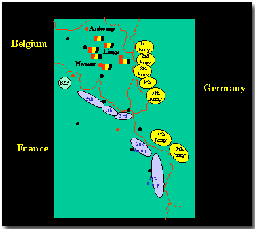We know that famous photographer Dorothea Lange was famous for her photography during the Dust Bowl. This photo was taken around the year 1936. This photo was one labeled under "Waiting for Work". Dorothea Lange explains that This family has been on the road for 13 years total. The man standing in the middle is a migrant worker who has a wife and a family that continues to grow. He goes from state to state with his family to look for places in where he can work picking wheat, cotton, peas, and even potato. Some of the states he travels to are New Mexico, Texas, and Arizona. He hopes to someday be able to buy his own place in the state of Idaho.
The reality is that he will probably never have enough money for this to happen. This is probably due to the fact that because of the dust bowl, many families were left without their homes. They may of had a place however, because of the dust bowl and the drought, it is likely that much land was left useless and their reason for moving around so much is that jobs must be scarce since many people were also looking for jobs as well. I can probably say that they were most likely forced to live this way and as we can see, they are all tattered and in sad conditions.
The government could of been helpful in this situation. It is customary, for example that the children would of been aided as part of the government. The government, as a responsibility should of ensured that that the family was taken care of. This family had been traveling and never settled down for 13 years in total. That must of meant something. A solution would be to obviously provide government assistance to these types of family. Perhaps giving them a place to stay would help them ensure that they are not moving around so much. As long as they were given something to start off with, im sure they would be fine.
Friday, March 21, 2014
Friday, March 7, 2014
Belgium
What must be known about Belgium's role in the First World War is that country was originally neutral. Before the War began, in the year of 1839, there was a treaty signed called the Treaty of London in which it would be stated that Belgium would remain neutral in any case of war. Later on in the 19th Century, Belgium was beginning to focus on land aquisition rather than actual militarism. They felt there was no need for one since they were in fact neutral. The problem with this is that Germany then felt that Belgium was an easy target to both conquer and destroy because of its proximity to France, and the easy route to this place as well. Once the war began, Belgium was not equiped to fight off the Germans who had an army of 5 million ready to fight, compared to 250,000 that Belgium had.

Once this invasion occurred, it was then that Great Britain found the excuse to fight Germany. Belgium did not want Germany to cross through because they knew this would mean there would be a war, and so it happened. As soon as Germany began to invade Belgium, Great Britain decided to declare war. While invading, all it took was a couple of hours to begin destroying many of the forts established for defense. On September 29th, Wavre St. Carherine, one of the forts was so badly ruined that it was as if it had been abandoned. By the 8th of October, it was decided that due to the increased war activity in Antwerp, it was decided that it had to be evacuated.
Once all of the countries were at war, they basically used Belgium as the middle man. Belgium was in between crucial areas for the Allied and Central powers in the war. Belgium was stuck being affected by the gunfire when they were, in reality attempting to stay out of the war. They were not prepared for such large attacks and were in turn affected the most. Geographically, they were important due to the fact that they were in the way of the German route to France.
Subscribe to:
Posts (Atom)
